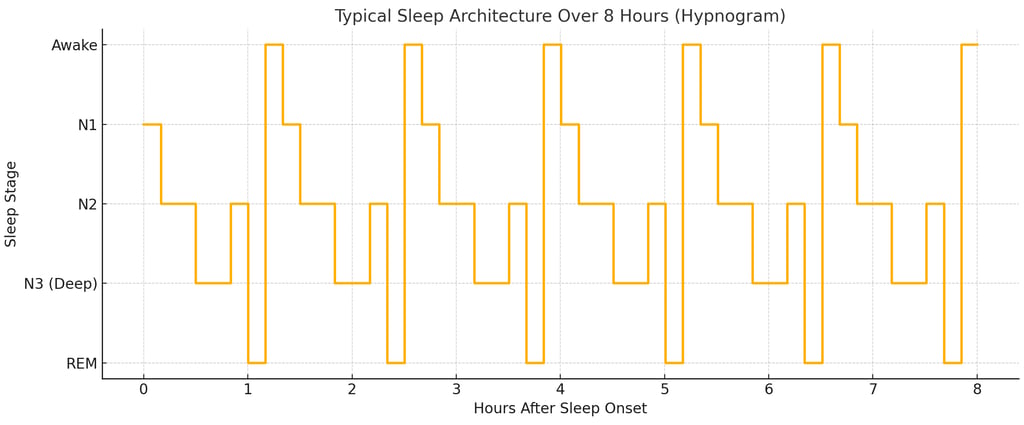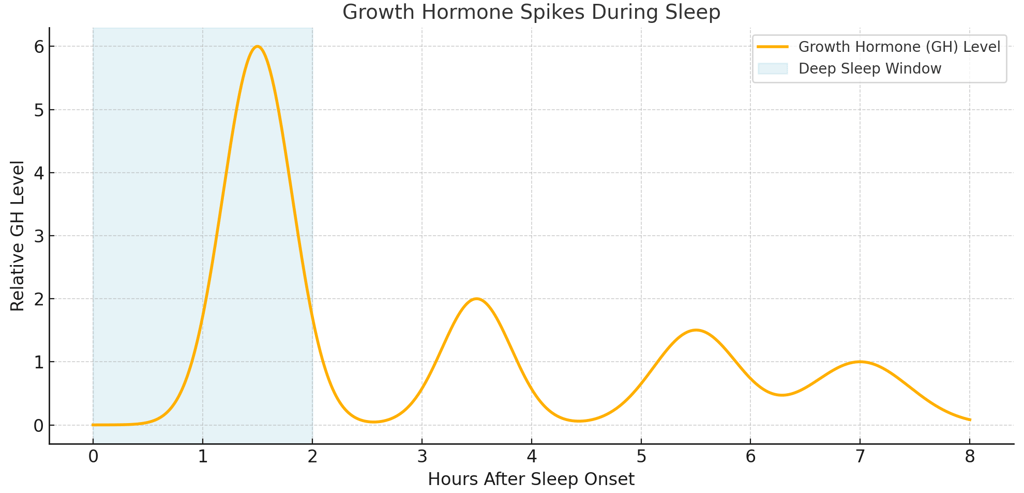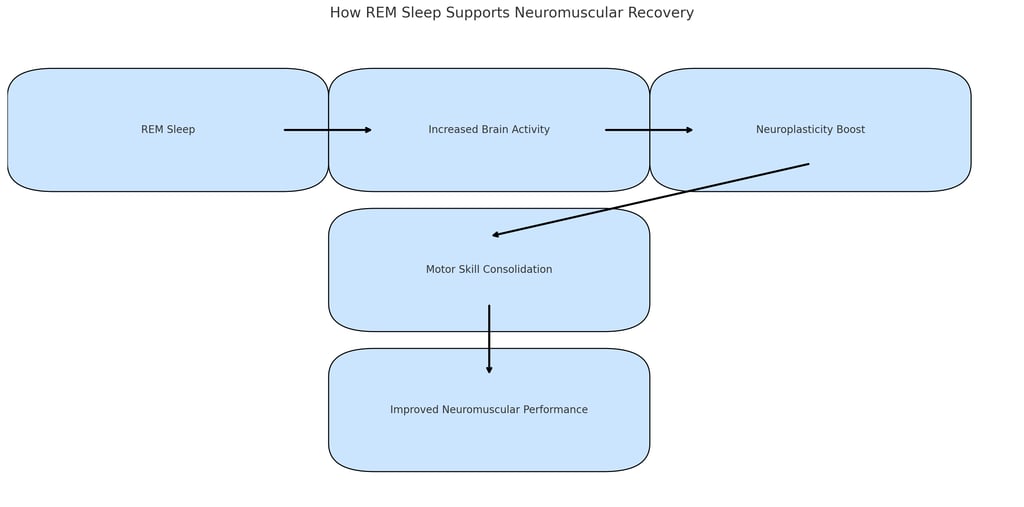Sleep Cycles and Muscle Recovery
What Science Says About Deep Rest


Why Sleep Matters More Than You Think
You can follow a perfect training program, hit your macros daily, and time every supplement down to the minute—but if you’re not getting quality sleep, your recovery and muscle gains will suffer. Sleep isn't just a passive recovery phase; it plays an active, biological role in repairing tissues, restoring energy systems, and supporting muscle protein synthesis. It’s where your body turns stimulus into adaptation.
In particular, REM sleep and deep sleep—two critical phases of the sleep cycle—have unique and essential roles in physical recovery. Deep sleep is when growth hormone surges and muscle repair occurs, while REM sleep contributes to neuromuscular coordination and central nervous system recovery. As research into sleep physiology advances, it’s becoming clear that rest isn’t just rest. Not all sleep is equal—and the quality, structure, and timing of your sleep cycles can directly impact your performance, body composition, and long-term progress.
Whether you're a seasoned athlete or someone starting a new fitness journey, this article breaks down the latest scientific findings on how sleep interacts with muscle recovery. We’ll explore how training intensity affects sleep needs, the role of deep and REM phases, and why missing sleep can sabotage your results—even if everything else is on point.
Understanding the Sleep Cycle
The 4 Stages of Sleep
Sleep isn’t a static state—it’s a dynamic, cyclic process that repeats every 90 to 110 minutes throughout the night. Each cycle moves through four distinct stages, grouped into Non-REM (NREM) sleep and REM sleep, each serving different physiological and neurological functions.
Stage N1 – Light Sleep (Transition)
This is the lightest and briefest stage of sleep, lasting only a few minutes. It marks the transition from wakefulness to sleep, where:
Brain activity begins to slow
Eye movements and muscle activity decrease
People may experience hypnic jerks or brief muscle twitches
This stage doesn’t contribute significantly to recovery, but it sets the stage for deeper, restorative sleep.
Stage N2 – Intermediate Sleep
N2 accounts for approximately 50% of total sleep time. Here, your body begins to fully relax:
Muscle tone decreases
Heart rate and breathing slow down
Body temperature drops
Sleep spindles and K-complexes appear on EEG—brainwave activity thought to help with memory consolidation and sensory processing
While not as restorative as N3, N2 plays an important supportive role in physical recovery by conserving energy and allowing for uninterrupted entry into deeper stages.
Stage N3 – Deep Sleep / Slow-Wave Sleep (SWS)
This is the most physically restorative phase of sleep, making it essential for muscle recovery, immune function, and hormonal balance. During N3:
Blood flow is redirected to muscles and tissues
Growth hormone (GH) is released in large pulses
Brain waves slow dramatically (delta waves)
The body repairs muscle fibers and builds new tissue
N3 typically dominates the first third of the night, especially if you fall asleep at a consistent hour. Disrupting this phase—via late bedtime, alcohol, or stress—can significantly impair recovery and training adaptation.
REM Sleep – Rapid Eye Movement
Unlike deep sleep, REM is marked by high brain activity, rapid eye movement, and vivid dreaming. It occurs later in the sleep cycle, and its duration increases with each cycle through the night.
REM sleep is critical for:
Motor learning and neuromuscular memory (e.g., mastering lifts or athletic movements)
Emotional regulation and mental resilience
Hormonal regulation (including cortisol and serotonin)
Integration of physical experiences with the nervous system
In other words, while N3 heals the body, REM reboots the mind and coordinates the brain-body connection—vital for athletic performance and mental sharpness.
Sleep Architecture Across the Night
Each night, you cycle through the four stages 4 to 6 times. However, the composition of each cycle changes:
Early sleep cycles (first 3–4 hours) are deep sleep dominant—this is when the majority of muscle repair and GH release occurs.
Later cycles shift toward longer REM phases, supporting cognitive and nervous system recovery.
This explains why sleeping only 4–5 hours deprives the body not just of total sleep time, but also of the critical late-night REM stages. And why both early and late sleep periods are essential—they each support different aspects of full recovery.


Deep Sleep and Muscle Protein Synthesis
The Role of Growth Hormone (GH)
Deep sleep—specifically N3 slow-wave sleep (SWS)—is when the body enters its most anabolic (tissue-building) state. During this stage, the pituitary gland releases pulses of growth hormone (GH), with the most significant spike occurring approximately 30 to 90 minutes after sleep onset. This surge is tightly linked to circadian rhythm and sleep depth, not just total sleep duration.
Growth hormone plays a central role in post-exercise recovery and muscle remodeling. It does this by:
Stimulating muscle protein synthesis (MPS) – GH enhances the uptake of amino acids and increases the rate of protein turnover, allowing damaged muscle fibers to be rebuilt stronger.
Promoting tissue regeneration – GH accelerates the repair of not just skeletal muscle, but also tendons, ligaments, and even cartilage.
Facilitating lipolysis – By mobilizing fat stores for energy, GH indirectly spares protein, aiding in the preservation and growth of lean mass.
Enhancing collagen synthesis – Critical for connective tissue health and joint resilience.
A landmark study published in The Journal of Clinical Endocrinology & Metabolism found that just one night of sleep restriction (4 hours) reduced GH secretion by up to 70%. Chronic sleep disruption has been shown to blunt the amplitude and frequency of GH pulses, especially in people who already engage in regular high-intensity or resistance training.
Muscle Recovery at the Cellular Level
Muscle protein synthesis doesn’t just "turn on" because of nutrients or training; it also requires biological readiness and cellular energy availability. During deep sleep, the body downregulates most non-essential functions like movement, digestion, and conscious cognition. This frees up ATP (adenosine triphosphate)—your cellular energy currency—for repair and rebuilding.
At the microscopic level, sleep facilitates:
mTOR pathway activation – This intracellular signaling pathway controls MPS and hypertrophy. Deep sleep indirectly enhances mTOR activity by maintaining a favorable hormonal profile (high GH, low cortisol).
Satellite cell activity – These muscle stem cells play a vital role in fiber regeneration and hypertrophy. Their proliferation and differentiation are influenced by GH and testosterone levels—both regulated during sleep.
Reduction of muscle protein breakdown (MPB) – Deep sleep lowers cortisol and other catabolic hormones, tipping the balance in favor of net muscle gain.
In short, without sufficient deep sleep, even a well-structured diet and training program cannot fully capitalize on the anabolic processes needed for muscle repair. You might hit your macros and train hard—but if you're not sleeping deeply, you're leaving gains on the table at the cellular level.


REM Sleep and Neuromuscular Recovery
Brain-Body Coordination
While deep sleep (N3) is the primary window for physical repair, REM sleep is where performance gains are locked in neurologically. Characterized by heightened brain activity, irregular breathing, and rapid eye movements, REM sleep is crucial for:
Motor learning and skill retention
Emotional processing and psychological resilience
Restoration of central nervous system (CNS) efficiency
Athletes, especially those engaged in complex or skill-based training (e.g., Olympic lifting, gymnastics, sprinting), rely on neuromuscular precision. This precision is refined and consolidated during REM. Motor patterns activated during the day are replayed and strengthened during REM, a process supported by neuroimaging studies that show repeated activation of motor cortex regions during this phase.
This phenomenon is closely tied to neuroplasticity—the brain's ability to adapt, rewire, and strengthen neural connections. Research shows that after a motor learning task (e.g., learning a new lifting technique), the amount of REM sleep increases. This suggests a bidirectional relationship: the more technical your training, the more REM your brain will prioritize to cement those patterns.
In practical terms, if you’re learning how to front squat properly, developing sprint mechanics, or rehabbing a motor pattern post-injury, REM sleep is where your nervous system organizes and refines that learning—without additional joint strain or muscular fatigue.
Cortisol and Stress Regulation
REM sleep is also critical for regulating cortisol, the body’s primary stress hormone. Cortisol follows a diurnal rhythm—low at night, rising in the early morning to help you wake up. Disruption of REM sleep throws this rhythm off, resulting in chronically elevated cortisol levels, especially in the evening.
Elevated cortisol can:
Break down muscle tissue (catabolism) by increasing muscle protein breakdown
Blunt muscle protein synthesis (MPS) by interfering with anabolic hormones like testosterone and IGF-1
Increase fat deposition, particularly visceral fat
Raise systemic inflammation, which impairs recovery and joint health
REM sleep also modulates the hypothalamic-pituitary-adrenal (HPA) axis, which governs the stress response. Without sufficient REM, your body stays in a higher sympathetic (fight-or-flight) state, even during rest periods, compromising both physical recovery and mental resilience.
In short: if you're chronically short-changing your REM sleep, you may find yourself hitting plateaus, struggling with CNS fatigue, or recovering poorly from workouts that previously felt easy.
Neuroscience-Backed Insight:
“Motor skill learning induces changes in sleep architecture, notably an increase in REM sleep, suggesting that sleep actively participates in the consolidation of motor memory.”
— Walker, M.P., et al., Nature Neuroscience (2002)
Reference:
Walker, M.P., Brakefield, T., Morgan, A., Hobson, J.A., & Stickgold, R. (2002). Practice with sleep makes perfect: Sleep-dependent motor skill learning. Nature Neuroscience, 5(11), 1156–1160.


How Training Intensity Affects Sleep Quality
Overreaching vs. Overtraining
Training at a high intensity is essential for progress, but without adequate recovery, it can backfire—especially when it comes to sleep. Exercise increases adenosine levels in the brain—a neuromodulator that promotes sleep pressure. This explains why moderate to high-intensity training often makes you feel more tired and can deepen sleep, particularly in the short term.
In the context of functional overreaching (temporary fatigue planned into a training cycle), the body compensates by increasing the proportion of slow-wave sleep (deep sleep) during recovery nights. This is beneficial and expected.
However, when overreaching turns into non-functional overreaching or full-blown overtraining syndrome (OTS)—where the body can no longer recover—sleep quality can deteriorate sharply. Common symptoms include:
Reduced deep sleep duration, particularly during early-night cycles
Delayed sleep onset, or taking longer to fall asleep despite fatigue
Frequent awakenings and nighttime restlessness
Elevated resting heart rate and heart rate variability (HRV) disruption during sleep, a sign of sympathetic nervous system over activation
In this state, the very system that supports adaptation (the parasympathetic nervous system) is overridden by stress signals, keeping the athlete in a mild state of physiological arousal—even during sleep. This leads to a vicious feedback loop:
Inadequate sleep impairs recovery → impaired recovery reduces performance → reduced performance encourages more training → more training further degrades sleep.
Without a strategic deload or a sleep-focused recovery phase, this can lead to chronic underperformance, injury, or burnout.
The CNS Load Factor
While most people associate fatigue with muscle soreness, not all training stress is muscular. Heavy resistance training, Olympic lifting, high-volume sprinting, and complex multi-joint movements all place a significant burden on the central nervous system (CNS).
Unlike muscular fatigue, CNS fatigue doesn’t produce DOMS—but it can severely impact:
Coordination
Reaction time
Movement accuracy
Overall power output
REM sleep plays a critical role in CNS recovery, particularly through its influence on synaptic plasticity, motor cortex reorganization, and emotional regulation. When REM is consistently cut short—either by sleep restriction, irregular sleep timing, or stimulants late in the day—the nervous system begins to show signs of strain:
Slower reflexes during lifts or sprints
Decreased precision or skill execution
Mental fog or hesitation in decision-making tasks (e.g., in sport situations)
Reduced resilience to training stress or life stress
In some cases, CNS overreaching may manifest as psychological fatigue, such as a lack of motivation, irritability, or anxiety about training sessions.
Scientific Insight:
A study published in the European Journal of Applied Physiology found that athletes undergoing intense training blocks without sufficient sleep showed significant reductions in reaction speed and neuromuscular control, even before any muscular overtraining symptoms appeared. This highlights the primacy of nervous system recovery in high-performance contexts, and the indispensable role of REM sleep in maintaining it.
Sleep Warning Signs During High-Volume Training
If you're increasing your training load, keep an eye on these early signals that your sleep—and recovery—may be compromised. Ignoring them could push you from functional overreaching into a recovery deficit.
Checklist: Signs Your Sleep Quality Is Declining
Longer sleep latency – You're physically exhausted but can't fall asleep within 20–30 minutes.
Frequent night wakings – Interrupted sleep becomes the norm, even without external disturbances.
Elevated resting heart rate (RHR) – Especially noticeable in the morning, indicating sympathetic dominance.
Daytime fatigue despite full sleep duration – You're still tired, mentally foggy, or unmotivated.
Mental burnout or dread before training – A sign your nervous system isn’t recovering overnight.
Plateauing or regressing performance – Power output, coordination, or technique starts to suffer.
If you’re experiencing two or more of these symptoms consistently, it’s time to re-evaluate your training-recovery balance. Consider introducing a deload week, prioritizing REM and deep sleep, and monitoring biofeedback like HRV.
What Happens When You Miss Sleep?
One Bad Night vs. Chronic Sleep Debt
Occasional poor sleep happens. A single night of inadequate rest—especially following intense training—may reduce growth hormone (GH) release and slightly impair muscle protein synthesis (MPS). You'll likely feel more fatigued, notice slower reaction times, and experience a dip in motivation or mood the next day.
But the real damage sets in with cumulative sleep debt. When sleep is restricted to less than 6 hours per night over several consecutive days, your body begins to shift into a catabolic (muscle-wasting) and inflammatory state.
Consequences of Repeated Sleep Restriction
Research published in Sleep journal found that just five nights of sleep restricted to 5 hours per night caused a 15% reduction in muscle protein synthesis following resistance training. That means even if you train hard and eat enough protein, your body lacks the hormonal and metabolic conditions needed to effectively repair and grow muscle tissue.
Other physiological consequences include:
Increased Inflammation
Sleep deprivation elevates pro-inflammatory cytokines like IL-6 (interleukin-6) and TNF-alpha (tumor necrosis factor-alpha).
Chronic inflammation impairs muscle recovery, joint health, and immune function.
Hormonal Disruption
Testosterone levels drop, especially in men, leading to reduced anabolic signaling.
Cortisol levels rise, increasing muscle protein breakdown (MPB) and abdominal fat storage.
Insulin sensitivity declines, reducing your ability to shuttle nutrients into muscle cells post-workout.
Glycogen and Energy Depletion
Inadequate sleep lowers glycogen storage capacity in both liver and muscle, leading to quicker fatigue and slower recovery in high-volume training blocks.
Athletes may feel "flat" or depleted, even with proper carbohydrate intake.
Impaired Injury Healing
Sleep supports tissue regeneration via fibroblast activity, collagen synthesis, and growth factor release. Sleep loss slows wound healing and increases risk of soft tissue re-injury, particularly when returning too quickly after a minor strain.
Functional Impairment Without Symptoms
What’s especially dangerous is that some athletes don’t "feel" sleep-deprived until performance has already started to decline. Sleep restriction can reduce:
Reaction time by 20–30% (comparable to mild alcohol intoxication)
Cognitive processing speed, impairing motor planning and decision-making in sport
Pain threshold, making DOMS and minor injuries feel more intense
In other words, you can be functioning below your potential—physically and mentally—without realizing that sleep is the limiting factor.
Ideal Sleep Duration and Timing for Lifters
Sleep quality isn’t just about hitting a number of hours—it’s about when and how you sleep. For lifters and athletes, the structure and consistency of your sleep can significantly impact recovery, strength gains, hormonal balance, and even injury risk.
General Guidelines for Physically Active Individuals
7–9 hours per night is the science-backed recommendation for adults, but lifters with high training volume or CNS-intensive workouts (e.g., heavy compound lifts, sprint intervals) may need closer to 8–9 hours for full recovery.
Deep sleep (N3 stage) is most prominent in the first third of the night, meaning that late bedtimes can reduce total N3 duration, even if you sleep the same number of hours.
A consistent sleep-wake schedule reinforces your circadian rhythm, allowing for more predictable surges in growth hormone, testosterone, and melatonin—all essential for anabolic recovery.
A 2021 study in the International Journal of Sports Physiology and Performance found that elite strength athletes who maintained consistent bedtimes had significantly lower cortisol levels and higher training adaptations over a 4-week period compared to those with irregular sleep patterns, even with similar sleep durations.
The Athlete’s Window: Timing Recovery for Maximal Benefit
1. Pre-Midnight Bedtime
“An hour before midnight is worth two after” may sound old-fashioned, but it holds biological truth. The earlier stages of the night are dominated by slow-wave sleep, which:
Peaks GH secretion
Maximizes muscle repair and protein synthesis
Supports immune function and glucose metabolism
Delaying bedtime shifts your sleep cycle forward, potentially compressing deep sleep and increasing your reliance on lighter N2 and REM in the morning—important, but not as recovery-centric.
2. Sleep in 90-Minute Multiples
Sleep cycles last approximately 90 minutes, and each cycle includes NREM and REM phases. Waking at the end of a cycle—for example, after 7.5 or 9 hours—reduces grogginess (sleep inertia) and improves morning alertness.
Use this rule to determine your ideal wake-up time, not just your bedtime.
3. Strategic Napping
Short naps (20–30 minutes) can be highly effective for CNS recovery, especially after high-intensity or volume-based workouts. They:
Improve alertness and reaction time
Boost memory consolidation
Support REM rebound if prior night’s sleep was shortened
However, avoid naps longer than 60 minutes late in the day, as they may reduce sleep pressure and delay nighttime sleep onset.
Tip: Track Your Sleep Architecture
Wearables like WHOOP, Oura, or Garmin can help you monitor actual time spent in deep and REM stages—not just total hours. This data can be invaluable when you're increasing training intensity or trying to optimize your recovery window.
How to Improve Sleep Quality for Better Recovery
Practical, Science-Backed Tips:
Create a Dark, Cool Environment
Optimal room temp: ~65°F (18°C)
Avoid blue light from screens 1–2 hours before bed
Avoid Alcohol and Caffeine Late in the Day
Caffeine has a half-life of 5–6 hours
Alcohol reduces REM sleep quality
Wind Down with a Sleep Routine
Stretching, meditation, or reading
Sleep apps that focus on parasympathetic activation
Track Your Sleep Cycles
Use wearables (Oura, WHOOP, Garmin) to analyze REM and deep sleep
Adjust training load if your recovery metrics tank
Carbohydrates Before Bed
Some research suggests a small carb-based snack can enhance tryptophan transport and improve sleep onset
Final Thoughts – Muscle Growth Starts in Your Sleep
Optimizing sleep and muscle recovery isn’t just about spending more time in bed—it’s about ensuring quality sleep architecture that aligns with your training intensity and recovery demands. Deep sleep fuels repair. REM supports coordination and stress regulation. Together, they lay the foundation for consistent muscle growth, improved performance, and injury resilience.
If you're serious about your training results, sleep should be treated as non-negotiable training infrastructure—not an afterthought.
References
Walker, M. P., Brakefield, T., Morgan, A., Hobson, J. A., & Stickgold, R. (2002).
Practice with sleep makes perfect: Sleep-dependent motor skill learning.
Nature Neuroscience, 5(11), 1156–1160.
https://pubmed.ncbi.nlm.nih.gov/12123620/Dattilo, M., Antunes, H. K., Medeiros, A., et al. (2011).
Sleep and muscle recovery: Endocrinological and molecular basis for a new and promising hypothesis.
Medical Hypotheses, 77(2), 220–222.
https://pubmed.ncbi.nlm.nih.gov/21550729/Knowles, O. E., Drinkwater, E. J., Urwin, C. S., et al. (2018).
Inadequate sleep and muscle strength: Implications for resistance training.
Journal of Strength and Conditioning Research, 32(8), 2319–2331.
https://pubmed.ncbi.nlm.nih.gov/29422383/Leeder, J., Glaister, M., Pizzoferro, K., Dawson, J., & Pedlar, C. R. (2012).
Sleep duration and quality in elite athletes measured using wristwatch actigraphy.
European Journal of Sport Science, 12(2), 119–126.
https://pubmed.ncbi.nlm.nih.gov/22329779/Van Cauter, E., & Plat, L. (1996).
Physiology of growth hormone secretion during sleep.
Journal of Pediatrics, 128(5 Pt 2), S32–S37.
https://pubmed.ncbi.nlm.nih.gov/8627466/Donga, E., van Dijk, M., van Dijk, J. G., et al. (2010).
A single night of partial sleep deprivation induces insulin resistance in multiple metabolic pathways in healthy subjects.
Journal of Clinical Endocrinology & Metabolism, 95(6), 2963–2968.
https://pubmed.ncbi.nlm.nih.gov/20371664/Hausswirth, C., & Mujika, I. (2013).
Recovery for Performance in Sport.
Human Kinetics.
https://www.amazon.com/Recovery-Performance-Institut-National-LExpertise/dp/1450434347Pejovic, S., Basta, M., Vgontzas, A. N., et al. (2013).
Effects of recovery sleep after one work week of mild sleep restriction on interleukin-6 and cortisol secretion and daytime sleepiness and performance.
American Journal of Physiology-Endocrinology and Metabolism, 305(7), E890–E896.
https://pubmed.ncbi.nlm.nih.gov/23941878/Fullagar, H. H. K., Skorski, S., Duffield, R., et al. (2015).
Sleep and athletic performance: The effects of sleep loss on exercise performance, and physiological and cognitive responses to exercise.
Sports Medicine, 45(2), 161–186.
https://pubmed.ncbi.nlm.nih.gov/25315456/Vitale, J. A., Bonato, M., Galasso, L., et al. (2017).
Sleep quality and high-intensity interval training at two different times of day: A crossover study on the influence of the chronotype in male collegiate soccer players.
Chronobiology International, 34(2), 260–268.
https://pubmed.ncbi.nlm.nih.gov/27906554/
Optimize Your Sleep
Unlock recovery and performance through deep sleep cycles for muscle growth and overall well-being.
Optimizing my sleep has significantly improved my recovery and performance. Deep rest truly fuels muscle growth. Highly recommend following these sleep tips for gains!
James L.

★★★★★
